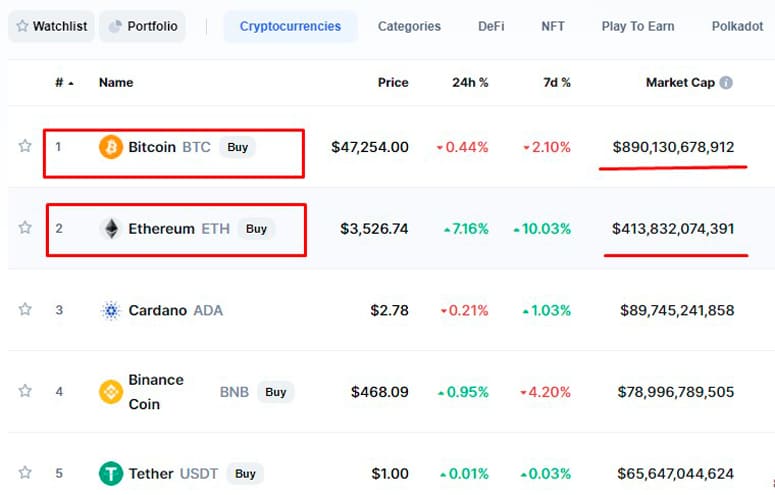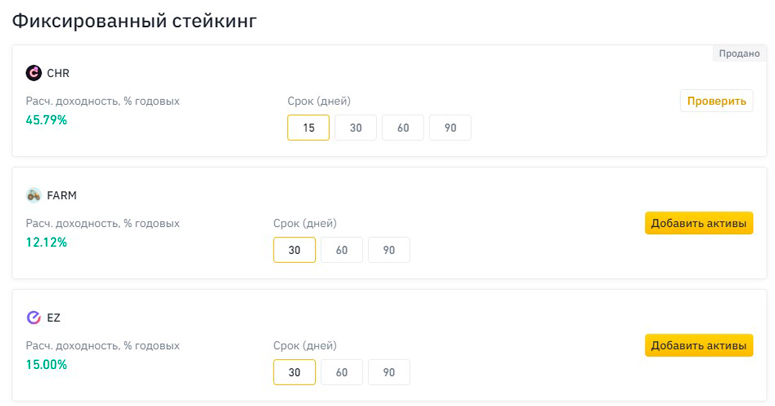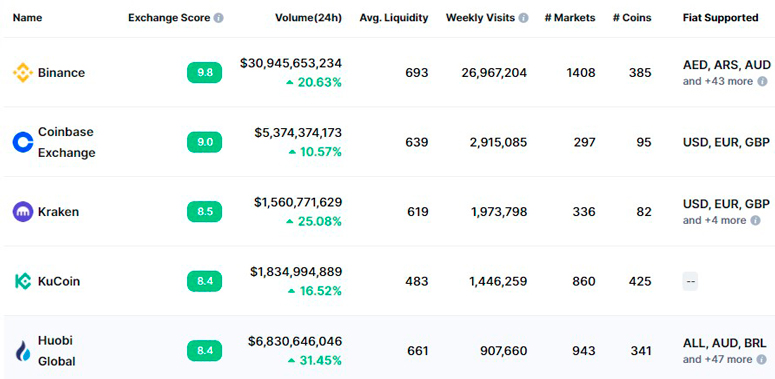Det är inte svårt att investera i bitcoin eller ether. Men kontroll över inkomstgenerering är kopplad till kompetent diversifiering av tillgångar (riskfördelning). Vissa investerare föredrar att köpa och inneha endast stora digitala valutor, medan andra experimenterar med lovande altcoins. I vilket fall som helst ger ett medvetet tillvägagångssätt för att sammanställa en investeringsportfölj för kryptovaluta fler möjligheter till vinst. Samtidigt måste investeraren ständigt arbeta med investeringarna.
Vad är en investeringsportfölj?
Det är en vanlig tro bland nykomlingar på kryptovalutamarknaden att innehav av Bitcoins är det enda sättet att dra nytta av digitala tillgångar. Det finns dock många fler möjligheter än att bara förvärva BTC.
En investeringsportfölj är en samling tillgångar: aktier, obligationer, fastigheter och digitala valutor. Kryptomarknaden är volatil och att bara äga en typ av mynt kan äventyra en investerares kapital och finansiella mål. Diversifiering hjälper till att bättre hantera potentiella vinster och förluster.
En kryptovalutaportfölj hjälper till att samla alla digitala tillgångar "under ett tak" för enkel hantering.
Fördelar med att skapa en
Huvudprincipen för investeringar är diversifiering. Att fördela kapital till olika typer av kryptovalutor eliminerar risken för varje enskild tillgång och gör att du kan balansera din portfölj utan att offra vinster.
Detta skyddar mot misslyckanden i enskilda protokoll, dåligt genomförande av projekt, juridiska problem, teknik av låg kvalitet. Om en investerare vet hur han ska fördela sitt kapital kommer han att kunna diversifiera de potentiella riskerna mellan flera koins.
5020 $
bonus för nya användare!
ByBit ger bekväma och säkra villkor för handel med kryptovalutor, erbjuder låga provisioner, hög likviditetsnivå och moderna verktyg för marknadsanalys. Den stöder spot- och hävstångshandel och hjälper nybörjare och professionella handlare med ett intuitivt gränssnitt och handledning.
Tjäna en 100 $-bonus
för nya användare!
Den största kryptobörsen där du snabbt och säkert kan börja din resa i kryptovalutornas värld. Plattformen erbjuder hundratals populära tillgångar, låga provisioner och avancerade verktyg för handel och investering. Enkel registrering, hög transaktionshastighet och tillförlitligt skydd av medel gör Binance till ett utmärkt val för handlare på alla nivåer!
Exempel på en färdig portfolio
Alla kryptovalutor utom Bitcoin kallas altcoins. Altcoins skiljer sig från BTC på många sätt. Till exempel tillåter tekniken i vissa nätverk att block skapas eller att transaktioner verifieras med hjälp av en annan konsensusmekanism, eller så erbjuder de nya funktioner - till exempel, smarta kontrakt.
Shitcoins är digitala valutor med låg kapitalisering. Tokens med värdelös eller svag teknik ingår också i denna kategori.
Altcoins kapitalisering och popularitet är lägre än det totala värdet av Bitcoin. Det finns dock en möjlighet att vinsterna från sekundära tokens kommer att bli betydligt högre under pampa. Genom att analysera positionen för de valda digitala mynten på marknaden kan du börja bygga en kryptovalutaportfölj.
Tabellen visar exempel på kapitaldiversifiering baserat på låg, medelhög och hög risktoleransnivå:
| Risknivå | BTC | ETH | BNB | DOT | ADA | Doge |
|---|---|---|---|---|---|---|
| Låg | 80% | 10% | 10% | – | – | – |
| Måttlig | 50% | 30% | 10% | 5% | 5% | – |
| Hög | 30% | 30% | 10% | 10% | 10% | 10% |
Hur man skapar en kryptovalutaportfölj
Oavsett vilka tillgångar en användare investerar i finns det tre gyllene regler för att sätta ihop en uppsättning investeringsverktyg:
- Fördela risker.
- Diversifiering mellan marknader (beroende på hur tekniken används).
- Överskatta inte riskerna i hopp om stora vinster. Det är bättre att ha 5 starkaste mynt än 50 genomsnittliga eller svaga tokens.
Princip för val av tillgångar
Att skapa en kryptovalutaportfölj börjar med att identifiera lämpliga mynt. För att utvärdera investeringspotentialen för en kryptovaluta är det viktigt att analysera följande parametrar:
- Marknadsvärde (summan av alla utgivna tokens i projektet, uttryckt i fiatpengar eller digitala tillgångar).
- Användbarhet (hur tillämpligt projektet är i verkliga livet).
- Teknik (vilka algoritmer och protokoll som används för att implementera blockkedjan).
- Målmarknad (den målgrupp som använder den föreslagna lösningen).
- Teamet och dess ledare (personerna bakom projektet och deras expertis).
- Projektfinansiering (den investering som går till implementering och utveckling av blockkedjan).
- Personlig risktoleransnivå (hur villig investeraren är att acceptera eventuella hot).
Diversifiering genom kapitalisering
Värderingen av kryptotillgångar är kopplad till detta kriterium. Marknadsvärde är det totala värdet av alla emitterade mynt, uttryckt i fiatvaluta (dollar, euro, rubel eller andra) eller i kryptovaluta (BTC, ETH och andra). Denna indikator återspeglar den nuvarande andelen digitala pengar på marknaden.
Kryptocommunityt är överens om att ju större marknadsvärde ett mynt har, desto mindre risk kan det utgöra. En uppskattning av det totala värdet på en virtuell valuta fastställs genom att multiplicera det aktuella priset med antalet mynt i omlopp.
Börsvärde = Aktuellt pris x cirkulerande utbud
Denna indikator talar till myntets popularitet. I slutet av augusti 2021 är ledaren för kryptovalutamarknaden Bitcoin med en kapitalisering på över $890 miljarder, följt av Ethereum (>$410 miljarder).

Alla digitala tillgångar på marknaden kan delas in i tre stora kategorier:
- Hög kapitalisering. Mynt från denna kategori har ett marknadsvärde på mer än $10 miljarder, så de kan vara en relativt säker investering. Det finns dock få sådana kryptovalutor.
- Medelhög kapitalisering. Det belopp som investerats i den digitala tillgången är mindre än $10 miljarder, men överstiger $1 miljarder.
- Låg kapitalisering. I denna kategori ingår mynt med ett totalt värde på mindre än $1 miljard.
Dessa siffror är viktiga eftersom de återspeglar myntens volatilitet. Giganter som BTC eller ETH är ganska stabila, även om de kan uppleva betydande prisfluktuationer jämfört med traditionella investeringsinstrument. Digitala valutor med liten kapitalisering anses vara högrisk. Dessa mynt är känsliga för marknadssentiment. Balansen mellan ovanstående 3 typer beror till stor del på investerarens risktolerans.
Diversifiering efter typ
En välkänd strategi för allokering av kryptotillgångar är att välja teknik som förbättrar vissa branscher.
En investerare tror till exempel att många människor snart kommer att arbeta på distans. Han analyserar de behov som kan uppstå till följd av denna förändring och de potentiella hoten. För alla branscher har spelförändrande teknik redan skapats. Därför kan vissa tokens bli vinnare, medan andra kommer att försvinna för alltid. Investerarens jobb är att tidigt identifiera de mest livskraftiga mynten och förvärva dem.
Denna kryptovaluta behöver inte nödvändigtvis vara marknadsledande. Även om den inte är bland de tio bästa kan token ge goda vinster.
Förstärkning av lovande områden
Den teknik som myntet bygger på är också viktig. Innan digitala valutor inkluderas i en kryptoportfölj är det nödvändigt att studera fördelarna och begränsningarna med blockchain för att förstå vilka problem som kan uppstå. Det är också nödvändigt att analysera lösningar på dessa problem. Till exempel hanteras Ethereums skalningsproblem genom att byta till en Proof-of-Stake-konsensusalgoritm. En metod i Bitcoin-blockkedjan för en liknande fråga är Lightning Network.
Båda teknologierna kan få ökad efterfrågan. Detta har en direkt proportionell effekt på värdet av investeringen.
Stablecoin
Stablecoins är mynt vars växelkurs är kopplad till riktiga valutor, främst den amerikanska dollarn. Det finns 2 typer av stablecoins: vissa backas upp 1:1 av fiat de backas upp av, medan andra backas upp av en kombination av olika kryptovalutor eller algoritmer.
USD Tether, USD Coin och True USD är mynt som är kopplade till den amerikanska dollarn.
DAI är en stablecoin som backas upp av en kryptovaluta utan fiat-backning. Algorand och Frax använder komplexa multi-token-ekosystem och Likviditetspooler att behålla en dollarbindning.
Säkerhetsmynt är de minst säkra tillgångarna för en kryptoportfölj. Stablecoins kan fungera som en buffert under tider då marknaderna är volatila. Om en investerare till exempel har 50% BTC och 50% USDT i sin $10 000-portfölj, en dag då Bitcoin sjunker 25% (vilket är möjligt), kommer det totala värdet på kryptovalutaportföljen bara att sjunka med 12,5% eller $1250. Detta är mycket säkrare än att hålla 100% i BTC. Då skulle förlusten vara $2500.
Således kan stablecoins tjäna till att skydda en del av en kryptoportfölj beroende på vilken risknivå en investerare väljer.
En förändring av Bitcoins pris i motsatt riktning skulle dock innebära förlorade vinster. Om Bitcoin stiger med 25% kommer de som innehar 50% BTC i en kryptoportfölj på $10,000 50% BTC att realisera $1250 i vinst. De som innehar 100% Bitcoin kommer att realisera en avkastning på $2500.
Att balansera risk och avkastning är viktigt för alla investeringsstrategier: det finns alltid en avvägning att göra.
Token för passiv inkomst
Ett sätt att öka kapitalet och samtidigt hålla det skyddat är att se till att säkrade tillgångar genererar avkastning. Om 50% av stablecoins ger en årlig procentuell avkastning (APY) på 10%, kommer värdet på en kryptoportfölj på $10 000 att öka med $550. Detta är möjligt så länge som de säkrade mynten skickas till stakning. Uniswap- och PancakeSwap-plattformarna erbjuder investerare möjlighet att tjäna ränta på att äga USDT, USDC, BUSD. Ju fler koins användare lagrar på sina plånböcker, desto högre inkomst kommer de att få.

Att stapla säkra tillgångar är en bra strategi för att skydda kapitalet och samtidigt maximera tillväxten. Att ha en hög andel stablecoins skapar ett solitt stöd under marknadsvolatilitet och säkerställer att en del av kryptoportföljen förblir säker.
Bonusar från börser
Att investera i virtuell valuta kan börja med att få gratis mynt. Många börser erbjuder bonusar till nya kunder. Utbytesplattformar är det viktigaste sättet att köpa och sälja tillgångar. På de flesta plattformar finns både Bitcoin och hundratals av alla slags altcoins tillgängliga. Användaren registrerar sig helt enkelt på börsen och får gratis mynt till sin plånbok. Till exempel ger Coinbase $5 i BTC för registrering.
Vid första anblicken verkar beloppet litet, men $5 i gratis tokens kan en dag ge en betydande ökning av tillgångarna.
Spekulativ kryptovaluta
Kryptotillgångarnas snabba uppgång och fall lockar handlare. Det är en vanlig praxis på marknaden att vinna eller förlora en stor andel av kapitalet i hög hastighet. Före tillgångsallokering tas därför hänsyn till för vilka ändamål mynten kommer att användas: aktiv handel eller långtidsförvaring.
Var ska man skapa
Vid en viss punkt blir det svårt för en investerare att övervaka tillgångarna i kryptovalutaportföljen och samla in information om hur priserna på varje specifik token rör sig. I det här fallet kan investeraren använda mjukvarulösningar för att övervaka sina digitala valutor.
Plånböcker för kryptovalutor
Ett mindre riskabelt alternativ för förvaring av kryptomynt. Användaren behöver inte oroa sig för att en börs ska hackas, vilket leder till förlust av digitala tillgångar eller på annat sätt missköta mynten. I detta avseende är kryptovalutaplånböcker säkrare än att lagra på centraliserade plattformar eller genom DeFi protokoll.
Programvaru- eller hårdvaruplånböcker ger den största tillgångssäkerheten.
För att se hela bilden av sina tillgångar använder investerare mjukvaruvalv för flera valutor som Exodus, Jaxx Liberty och andra. Ytterligare skydd av privata nycklar tillhandahålls av Ledger eller Trezor hårdvaruplånböcker.
Börser för kryptovalutor
Att hålla tillgångar i växlingstjänster som Coinbase, Binance och andra innebär att du äventyrar din portfölj. Såvida inte investerare aktivt handlar på en börs. Problemet med utbytesplattformar är att de lagrar kryptovalutan för alla sina användare. Således är utbyten riktade av hackare som ofta hackar dem.
Enligt CoinMarketCap, från och med augusti 2021, är de populära centraliserade kryptovalutaväxlingsplattformarna:
- Binance.
- Coinbase Utbyte.
- Huobi Global.
- FTX.
- Kraken.

Ett annat alternativ är att förvara tillgångar på decentraliserade plattformar som inte kräver att investerarna släpper kontrollen över sina privata nycklar.
Uppföljning och ombalansering
Marknadsvärdet för en virtuell valuta är ett mått på myntets värde. Ju mer en investerare diversifierar till volatila tillgångar, desto oftare måste kryptoportföljen ombalanseras. Detta skyddar tillgångarna från oplanerade risker.
Ombalansering av portföljen är omfördelningen av tillgångsandelar för att balansera risken. Ombalansering av kryptoportföljstrukturen innebär att man köper eller säljer mynt för att nå en målnivå för möjlig fara. Detta är dock inte den enda funktionen. Ombalansering kontrollerar psykologin i investerarens önskan att ständigt slå marknaden och eliminerar känslor. Ur denna synvinkel är det mycket lättare att göra en rationell och logisk bedömning av risktoleransen och välja lämplig strategi.
Verktyg för övervakning
Crypto-portföljspårare gör det möjligt för investerare att övervaka sina digitala valutor. Användare kan hantera tillgångar med ett enda konto. Med hjälp av övervakningsverktyg kommer investerare att se vinst och förlust och marknadspriser i realtid. Google har identifierat 5 populära trackers baserat på frågor på sin sökmotor:
- Blockfolio.
- Delta.
- CMA.
- CoinStats.
- BitUniverse.
Allmänna tips för att sammanställa en portfölj
Att investera i virtuell valuta är fortfarande ett riskfyllt företag. Och även om kapitaldiversifiering är utmanande och tar tid att undersöka och analysera, kommer en investerare som vet hur man bygger en balanserad portfölj att lyckas med att uppnå sina mål.
Om en investerare vill "sova lugnt" när de diversifierar kapitalet kommer de att bedöma sin riskaptit, samt analysera aktiviteten i kryptovalutaprojektets community och de potentiella tillämpningarna av token. Dessa och andra faktorer kommer att bidra till att maximera den potentiella avkastningen på investeringen.
Vanliga frågor och svar
❓ Hur många kryptovalutor ska jag ha i min portfölj?
Beror på investerarens riskprofil. För de minst riskfyllda investeringarna räcker det med 3 kryptovalutor med den högsta kapitaliseringen: BTC, ETH, USDT.
❔ Vad betyder HODL?
I kryptovaluta slang är detta namnet på "buy and hold" -strategin. HODL står för det felstavade ordet "hold".
⏳ Hur ofta bör en portfölj ombalanseras?
Investerare skiljer på två strategier för riskbalansering: efter tid (efter ett förutbestämt intervall - dag, månad, år) och efter avvikelse (när en tillgångs vikt överstiger ett visst värde).
💸 Hur många kryptovalutor är i omlopp i världen?
I augusti 2021 fanns det 11 382 mynt officiellt registrerade.
❗ Vilken strategi är bättre: handel eller HODL?
För det andra. Vid handel är riskerna högre, 95% av nybörjare spekulanter förlorar pengar. Därför beror valet på investerarens riskprofil.
Ett misstag i texten? Markera det med musen och tryck på Ctrl + Enter.
Författare: Saifedean Ammous, en expert på kryptovalutans ekonomi.















